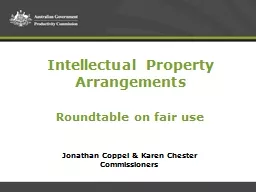

Commissioners Intellectual Property Arrangements Roundtable on fair use About the inquiry How did we go about this task Asked by government to look at Australias IP arrangements to ensure they encourage creativity and user access ID: 544776
Download Presentation The PPT/PDF document "Jonathan Coppel & Karen Chester" is the property of its rightful owner. Permission is granted to download and print the materials on this web site for personal, non-commercial use only, and to display it on your personal computer provided you do not modify the materials and that you retain all copyright notices contained in the materials. By downloading content from our website, you accept the terms of this agreement.
Slide1
Jonathan Coppel & Karen ChesterCommissioners
Intellectual PropertyArrangements
Roundtable on fair useSlide2
About the inquirySlide3
How did we go about this task?Asked by government to look at Australia’s IP arrangements to ensure they encourage creativity and user accessSought evidence:Consultations and roundtablesPublic submissionsDraft report for comment and feedbackSlide4
How did we go about this task?More consultations to comeSubmissions on draft reportAdditional roundtablesHearingsFinal report to be delivered to government later this yearSlide5
About todaySlide6
Purpose of roundtableDiscuss the draft recommendation on fair use Seek further evidence on the magnitude of costs and benefitsReduce any ambiguity to ensure final recommendation is clear and understandableHighlight any other ambiguitiesSlide7
Conduct of roundtableDiscussions today will occur under ‘Chatham House’ rulesWe will provide a copy of this presentation and a list of roundtable attendees on our webpage shortlySlide8
Specific issues to cover todayCertainty/uncertainty tradeoffFairness factorsIllustrative usesFair use and statutory licensingSlide9
Our draft fair use recommendation:
what did we recommend and why?Slide10
What we consider current deficiencies in the systemExceptions an important part of getting the balance rightCurrent exceptions are narrow and legalistic, rather than focused on the principle of fairnessPast changes to exceptions have largely just ‘caught up’ with societyPrevious expansions of copyright not balanced by expansion of user rightsSlide11
What did we recommend?Draft recommendation has several parts:Closed fair dealing exceptions replaced with open-ended fair use exceptionException should include ‘fairness factors’ to guide user and judicial decisionsNon-exhaustive list of uses provide further guidance and certaintyAn ‘objects clause’ and clear explanatory memorandum to provide further guidanceSlide12
Some key differencesFair dealingExisting arrangements potentially more certainResponsibility for changing exceptions lies with elected representatives
Fair useIs general – can apply to any circumstance provided a use is fairAllows the law to adapt to new legitimate usesCan permit new uses that don’t undermine economic incentive to createSlide13
Options for reducing uncertaintyAn objects clause in the Act to guide the application of the exceptionGuidance in the legislation similar to current research and study exceptionGuidelines developed by content creators and user groupsUse of foreign jurisprudenceSlide14
Questions for discussionIs fair use as uncertain as argued?Is fair dealing as certain as argued?Can guidelines reduce uncertainty? Should guidance be embedded in legislation?Slide15
Our draft fairness factorsThe effect of the use on the market for the copyright protected work at the time of the use The amount, substantiality or proportion of the work used, and the degree of transformation applied to the work
The commercial availability of the work at the time of the infringement The purpose and character of the use, including whether the use is commercial or private use. Slide16
Just a reminder…. the ALRC factorsthe purpose and character of the usethe nature of the copyright materialthe amount and substantiality of the part used
the effect of the use upon the potential market for, or value of, the copyright materialSlide17
Why different factors to the ALRC?ALRC approached fair use from a legal perspectiveBuild on Australian fair dealingMinimise difference to fair use overseasOur recommendation focusses on achieving an economic outcomeFeedback in submissions suggesting overlap between the two approachesSlide18
Questions on fairness factorsWhat is the likely impact of these factors?Are there meaningful differences between the PC and ALRC factors?Any potential unintended consequences from the factors?Can the fairness factors account for other issues, such orphan works?Slide19
Non-exhaustive illustrative usesFair use should have illustrative uses Act as guidance to users and the courts about the kinds of uses that should be considered fairDrawn from the list proposed by the Australian Law Reform CommissionExpanding on existing fair dealing and other exceptionsSlide20
Non-exhaustive illustrative usesFair dealing exceptionsResearch or studyCriticism or reviewParody or satireReporting news
Professional advicePicking up other existing exceptionsQuotationNon-commercial private useIncidental or technical useLibrary or archive use
Education
Access for people with disability
Additional illustrative fair uses Slide21
Fair use and statutory licensingNot all illustrative uses will be ‘fair’Statutory licensing designed to reduce transaction costs for the government and education sectorsWhere a use is considered ‘fair’ it should be non-remunerableStatutory licences exist for all other usesSlide22
Impact of fair use for education?Illustrative uses are just that – illustrativeEducational institutions could potentially rely on fair use with or without it being an illustrative useFairness factors designed to account for harm to creators, amount of copying and degree of transformationSlide23
QuestionsWhat role do illustrative uses play in fostering certainty?Are they necessary in an open ended exception regime?Should other illustrative uses be included?Slide24
Further material on our websiteCopyright fact sheets and draft available on our websitehttp://www.pc.gov.au/inquiries/current/intellectual-property/